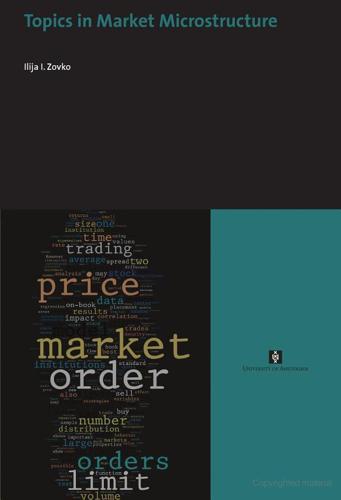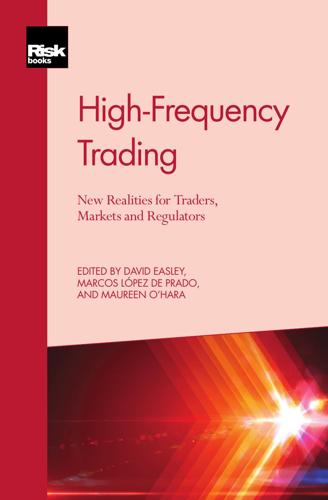continuous double auction
4 results back to index

pages: 119 words: 10,356
Topics in Market Microstructure by Ilija I. Zovko
Brownian motion, computerized trading, continuous double auction, correlation coefficient, financial intermediation, Gini coefficient, information asymmetry, market design, market friction, market microstructure, Murray Gell-Mann, p-value, power law, quantitative trading / quantitative finance, random walk, stochastic process, stochastic volatility, transaction costs
In this screen the traders are displayed, among some general stock information such as the previous day closing price and volume, also the current best bid and ask prices and volumes and also up to 5 levels of bid and ask limit orders in the limit order book. 3 CHAPTER 1. INTRODUCTION Once the opening auction is over, the market enters the continuous double auction phase. The possible uncleared orders from the auction are transfered to the order book. The continuous double auction is the main trading phase of the market. Traders may continuously submit orders to buy or sell and possible trades are cleared instantly. The main two types of orders are limit orders and market orders. A sell (buy) limit order is an offer to sell (buy) a specific amount of shares at a specified price or higher (lower).
…
This is in contrast to papers testing standard models based on rationality, which are typically forced to add strong auxiliary assumptions not contained in the original theoretical model, making the final results essentially qualitative. We present a brief review in the Supplementary Material (SM), Section 3.5.1. 3.1.1 Continuous double auction The continuous double auction is the most widely used method of price formation in modern financial markets. The auction is called “double” because traders can submit orders both to buy and to sell and it is called “continuous” because they can do so at any time. Under the terminology we use here, an order that does not cross the opposite best price, and so does not result in an immediate transaction, is called a limit order.
…
iv Contents 1 Introduction 1.1 The London Stock Exchange and the 1.1.1 Trading day . . . . . . . . . . 1.1.2 Member firms . . . . . . . . . 1.1.3 The LSE dataset, preparation 1.2 Summary of chapters . . . . . . . . . . . . . . 1 2 2 4 5 6 2 The power of patience: A behavioral regularity in limit order placement 2.1 Introduction . . . . . . . . . . . . . . . . . . . . . . . . 2.2 Description of the London Stock Exchange data . . . . 2.3 Properties of relative limit order prices . . . . . . . . . 2.3.1 Unconditional distribution . . . . . . . . . . . . 2.3.2 Time series properties . . . . . . . . . . . . . . 2.4 Volatility clustering . . . . . . . . . . . . . . . . . . . . 2.5 Conclusion . . . . . . . . . . . . . . . . . . . . . . . . 9 9 11 12 12 15 17 19 3 The predictive power of zero intelligence in financial markets 3.1 Introduction . . . . . . . . . . . . . . . . . . . . . . . . 3.1.1 Continuous double auction . . . . . . . . . . . 3.1.2 Review of the model . . . . . . . . . . . . . . . 3.1.3 Predictions of the model . . . . . . . . . . . . . 3.2 Testing the scaling laws . . . . . . . . . . . . . . . . . 3.2.1 Data . . . . . . . . . . . . . . . . . . . . . . . . 3.2.2 Testing procedure . . . . . . . . . . . . . . . . 3.2.3 Spread . . . . . . . . . . . . . . . . . . . . . . . 3.2.4 Price diffusion rate . . . . . . . . . . . . . . . . 3.3 Average market impact . . . . . . . . . . . . . . . . . 3.4 Conclusions . . . . . . . . . . . . . . . . . . . . . . . . 21 21 22 24 25 26 26 27 28 28 29 34 v LSE data . . . . . . . . . . . . . . . . . . and cleaning . . . . . . . . . . . . .

pages: 252 words: 73,131
The Inner Lives of Markets: How People Shape Them—And They Shape Us by Tim Sullivan
Abraham Wald, Airbnb, airport security, Al Roth, Alvin Roth, Andrei Shleifer, attribution theory, autonomous vehicles, barriers to entry, behavioural economics, Brownian motion, business cycle, buy and hold, centralized clearinghouse, Chuck Templeton: OpenTable:, classic study, clean water, conceptual framework, congestion pricing, constrained optimization, continuous double auction, creative destruction, data science, deferred acceptance, Donald Trump, Dutch auction, Edward Glaeser, experimental subject, first-price auction, framing effect, frictionless, fundamental attribution error, George Akerlof, Goldman Sachs: Vampire Squid, Gunnar Myrdal, helicopter parent, information asymmetry, Internet of things, invisible hand, Isaac Newton, iterative process, Jean Tirole, Jeff Bezos, Johann Wolfgang von Goethe, John Nash: game theory, John von Neumann, Joseph Schumpeter, Kenneth Arrow, late fees, linear programming, Lyft, market clearing, market design, market friction, medical residency, multi-sided market, mutually assured destruction, Nash equilibrium, Occupy movement, opioid epidemic / opioid crisis, Pareto efficiency, Paul Samuelson, Peter Thiel, pets.com, pez dispenser, power law, pre–internet, price mechanism, price stability, prisoner's dilemma, profit motive, proxy bid, RAND corporation, ride hailing / ride sharing, Robert Shiller, Robert Solow, Ronald Coase, school choice, school vouchers, scientific management, sealed-bid auction, second-price auction, second-price sealed-bid, sharing economy, Silicon Valley, spectrum auction, Steve Jobs, Tacoma Narrows Bridge, techno-determinism, technoutopianism, telemarketer, The Market for Lemons, The Wisdom of Crowds, Thomas Malthus, Thorstein Veblen, trade route, transaction costs, two-sided market, uber lyft, uranium enrichment, Vickrey auction, Vilfredo Pareto, WarGames: Global Thermonuclear War, winner-take-all economy
They existed back in the fifth century BC, when Roman historian Herodotus describes descending price auctions (where the price starts high and is gradually lowered until a bidder jumps in to purchase the item) as the mechanism of choice for marrying off young well-to-do Babylonian women. (Descending price auctions are still in use today to sell flowers in Holland; as a result, they’re called Dutch auctions.) Auctioneers have experimented with all sorts of different rules and protocols over the centuries. There are Japanese auctions, reverse auctions, double auctions, continuous double auctions, Yankee auctions. In a Scottish (or time-interval) auction, all bidding must close within a prespecified time period. In seventeenth-century England, a variant on the Scottish auction was used where the time of the auction’s close was uncertain, dictated by the exact moment when a candle of, say, an inch in length burned out (“candle” auctions are still used to sell wine in France and for government procurement contracts in Brazil).

High-Frequency Trading by David Easley, Marcos López de Prado, Maureen O'Hara
algorithmic trading, asset allocation, backtesting, Bear Stearns, Brownian motion, capital asset pricing model, computer vision, continuous double auction, dark matter, discrete time, finite state, fixed income, Flash crash, High speed trading, index arbitrage, information asymmetry, interest rate swap, Large Hadron Collider, latency arbitrage, margin call, market design, market fragmentation, market fundamentalism, market microstructure, martingale, National best bid and offer, natural language processing, offshore financial centre, pattern recognition, power law, price discovery process, price discrimination, price stability, proprietary trading, quantitative trading / quantitative finance, random walk, Sharpe ratio, statistical arbitrage, statistical model, stochastic process, Tobin tax, transaction costs, two-sided market, yield curve
That being said, what we have covered in this section is a framework for how to look for sources of potential profits in a principled way (by defining state spaces, examining potential features and their interplay, using training-test set methodology, imposing sensible value functions, etc) that should be a part of the arsenal of a quantitative professional, so that we can at least discuss these problems in a common language. MACHINE LEARNING FOR SMART ORDER ROUTING IN DARK POOLS The studies we have examined so far apply machine learning to trading problems arising in relatively long-standing exchanges (the open limit order book instantiation of a continuous double auction), where microstructure data has been available for some time. Furthermore, this data is rich, showing the orders and executions for essentially all market participants, comprising multiple order types, etc, and is also extremely voluminous. In this sense these exchanges and data are ideal test beds for machine learning for trading, since (as we have seen) they permit the creation of rich feature spaces for state-based learning approaches.

pages: 442 words: 39,064
Why Stock Markets Crash: Critical Events in Complex Financial Systems by Didier Sornette
Alan Greenspan, Asian financial crisis, asset allocation, behavioural economics, Berlin Wall, Black Monday: stock market crash in 1987, Bretton Woods, Brownian motion, business cycle, buy and hold, buy the rumour, sell the news, capital asset pricing model, capital controls, continuous double auction, currency peg, Deng Xiaoping, discrete time, diversified portfolio, Elliott wave, Erdős number, experimental economics, financial engineering, financial innovation, floating exchange rates, frictionless, frictionless market, full employment, global village, implied volatility, index fund, information asymmetry, intangible asset, invisible hand, John von Neumann, joint-stock company, law of one price, Louis Bachelier, low interest rates, mandelbrot fractal, margin call, market bubble, market clearing, market design, market fundamentalism, mental accounting, moral hazard, Network effects, new economy, oil shock, open economy, pattern recognition, Paul Erdős, Paul Samuelson, power law, quantitative trading / quantitative finance, random walk, risk/return, Ronald Reagan, Schrödinger's Cat, selection bias, short selling, Silicon Valley, South Sea Bubble, statistical model, stochastic process, stocks for the long run, Tacoma Narrows Bridge, technological singularity, The Coming Technological Singularity, The Wealth of Nations by Adam Smith, Tobin tax, total factor productivity, transaction costs, tulip mania, VA Linux, Y2K, yield curve
Hundreds of experiments on artificial markets constructed and performed with students from economics classes and with professionals have shown the crucial importance of repeating interactions in the presence of unconscious decisions in order to lead to an apparent rationality in rule-governed problems [390]. In these socalled continuous double auction experiments, which attempt to mimick real market situations, subjects have private information on their own willingness-to-pay or willingness-to-accept schedules which bound the prices at which each can profitably trade. No subject has information on market supply and demand. After an experiment, upon interrogation, the participants deny that they could have maximized their monetary earnings or that their trading results could be predicted by a theory.